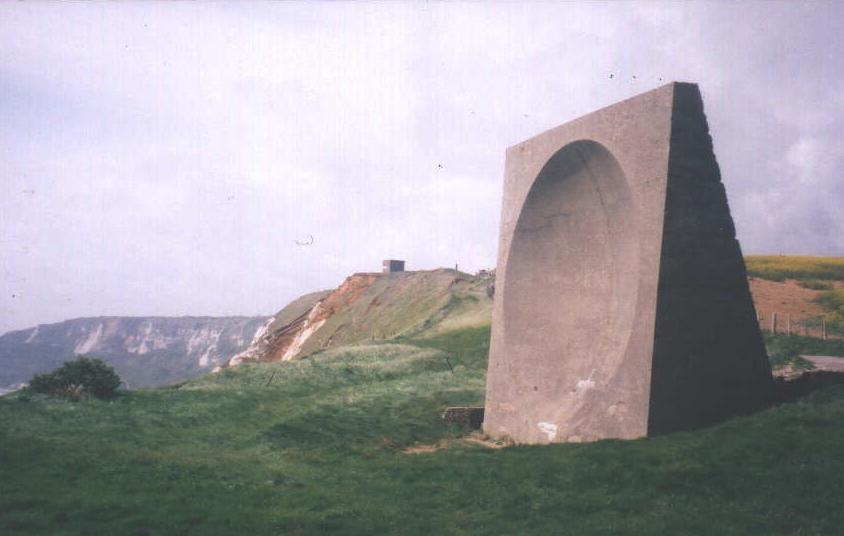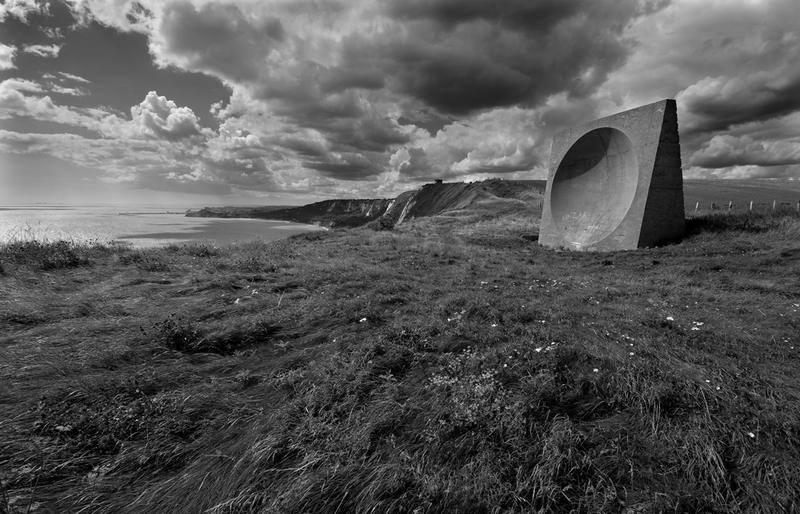Pete Graves e-mails to say the Abbot’s Cliff sound mirror was constructed by Lewis Brothers, Builders, of Dover. My father-in-law was apprenticed to Lewis’s in 1926 as a carpenter, and he worked on the wooden form-work around which the concrete for the mirror was ‘cast’. My father-in-law never visited the site and neither have my wife and I!”
Abbot’s Cliff
Kent History Forum photos
Sound mirrors on the Kent History Forum. There is lots of other good stuff on the site, too.
- Abbot’s Cliff. Including an aerial photo.
- Denge.
on the last official walk … there was round 300 hundred of us
. - Fan Hole, near Dover.
- Hythe.
- Joss Gap (Kingsgate).
Joss bay had two sound mirrors one being a slab, this was cut into the cliff near by the castle keep hotel , now replaced by flats.a slight indentation can still be seen near the top of the cliff. Checking the site where the round mirror was, which was a timber frame rendered. a few years ago the telephone cable blocks were still in place.
- Warden Point. With a good 1978 photo of it about to go over the cliff.
Abbot’s Cliff photo
Sound Mirror on cliffs above Dover at Exploring the Kent Coast (and a bit of E. Sussex) by Sally Swan.
Abbot’s Cliff hum and gusts
A 75 second recording of the wind at the Abbot’s Cliff sound mirror on 2 April 2009 by Steven Rowell. Evident in this recording, with mic placed directly on concrete mirror concave face, is a noticeable, resonant hum below 150Hz. Wind gusts on the cliffs were quite strong.
It is from radio aporee ::: maps
an open project about the creation and exploration of public soundscapes. it collects and organizes recordings of daily surroundings and other sonic habitats from all over the world. the sounds are organized within a mashup system of mapping software, databases, telephone networks and the Internet. sites and sounds can also be explored and accessed in situ by recent GPS-enabled mobile devices.
Abbot’s Cliff sound mirror photo
A photograph of the Acoustic Sound Mirror, Abbot’s Cliff, Dover, Kent, UK taken by Mike Franklin on 15 March, along with other photos of sights between Dover and Folkestone.
The ice mirror cometh
It’s a bit cold outside — but not cold enough to make a sound mirror out of ice, which is what has been done in Alaska!

The mirror was created as part of the Freeze celebration of Alaska and life in the North
held in Anchorage during January 2009. It was designed by Klaus Mayer, Petra Sattler-Smith and Marisa Favretto, who were inspired to create the ice mirror by the British sound mirrors.
Sound Mirror is inspired by Northern states of change and flux in weather, environment, light and atmosphere. We are interested in emphasizing these juxtapositions, highlighting the states in nature that are significant to states of perception. We are interested in the work acting as a mirror to the elements – light, landscape, passing birds, planes, sounds, while creating a space/form specific to viewer interaction – via size, orientation, composition.
The form is inspired by sound mirrors – a form built around coastal towns in England between 1915 and 1930 to function as an acoustic radar for approaching war planes. The first one was carved out of the chalk cliff on the coast in 1915.
Source: Freeze project
Photographs of the mirror being built from blocks of ice.
The PDF explaining the initial design concept includes a photograph of the Abbot’s Cliff sound mirror near Folkestone.
The completed mirror was praised by Michelle Mitchell in The Freeze Art Show at a Healthy Ten Below at Scribbit:
The most beautiful of the exhibits was a sound mirror that must have been fifteen or sixteen feet high and was built from this gorgeous frosty blue ice that almost looked like it was resin rather than ice. The blocks fit perfectly together to form this giant slab with a concave center so that if you stood on the platform opposite and spoke toward the dish it would reflect your voice back at you.
Source: Scribbit 2009-01-12
There is also a picture of the finished installation on Flickr. Anyone got any more good pictures of it?
History of the Future of War Noises
The Sound Mirrors: A History of the Future of War Noises is a July 2008 article by Ithamar Silver from Le Panoptique.
Although “not part of architectural history proper,” a series of moss and graffiti covered ruins along England’s southeastern coast belies one of the more grandly misguided displays of national insecurity to be produced by the tumult of the twentieth century. The remains are as imposing and impenetrable as any fortress—yet these were not traditional fortifications meant to withstand an enemy onslaught, a fact that renders their solidity largely palliative.
They were, essentially, ears.
(where it says one in Boulby that had somehow been transformed into a private residence
, it should presumably read “Selsey”)

Meanwhile, Peter Frost has sent this photo of the Abbot’s Cliff sound mirror, which he came across whilst walking towards Dover from Capel-le-Ferne in Kent.
More photos of Abbot’s Cliff
Another photo of the Abbot’s Cliff mirror between Folkestone and Dover, take in June by Hilary who says “Fascinated as we had never seen one before. Now planning to check some others out.”
Shepway council has a general view of the cliff but the mirror isn’t visible.
Meanwhile, an architect in Seattle e-mails to say An architect friend of mine sent me your link and to tell you the truth, I have found it fascinating. I couldn’t have even imagined anything such as this existing. The structures are unique, reminiscent of some ancient civilizion or culture. I was absolutely intrigued by the construction, form and design of the assemblage.
Abbot’s Cliff photo
Abbot’s Cliff sound mirror pictures
Eugene has sent me three nice photos of the Abbot’s Cliff sound mirror, on the white cliffs near Folkestone.
The Abbot’s Cliff mirror is at grid reference TR27083867, between Folkestone and Dover. It is very easy to find, simply follow the tarmac path along the cliff top, and you can’t really miss it (it is a great big block of concrete, after all!). It is a five to ten minute walk from the Folkestone – Dover road.




